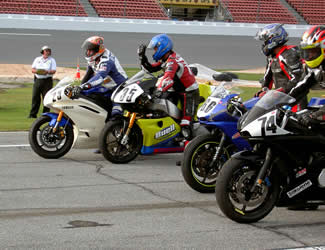Our Factory Crew Chief Survives and Returns from Daytona, Further Musings.

Ok, first things first. I need to have a word with you! Yes you, the one reading this column. You have to help me out. Every month I wait until hours before my column is due checking my email to see if any of you has sent me any technical questions that I can use to write my column. After pouring over 4 pages of requests for cheap Viagra and offers of increased sexual capacity, I sigh and try and think of something to write that won’t bore you to tears. My email address is on the bottom, USE IT! If you have a question, even one you may think might be trite, chances are 10 other people are wondering the same thing, so send me a note.
I find it encouraging how fast technology driven at the Moto GP level trickles its way down to what we see on our showroom floors. Not too long ago it took four or five years for technology tested at the highest levels of competition to find its way to the street or the dirt. Part of the problem was that the Premier Road racing class where the manufacturers spent the majority of their time, money and effort was based on the 500cc two-stroke engine, which didn’t provide them with much new technology that was applicable to their street bikes. It was for this reason, in the late 1990’s Honda and Yamaha proposed that the premier 500 GP class be changed to something that allowed them to develop technology that could be used on the street. So, in part thanks to that change, in the last five years we are seeing four stroke Moto GP technology show up on our street bikes at an incredibly fast level.
As I discussed in my clutch articles, the first very high horsepower, high compression Moto GP engines used slipper clutches to help control the unsettling forces generated when the tire tries to turn over the crankshaft on corner entry. It was found over the course of a race, that the clutches were generating far too much heat and were wearing significantly; in short, they needed help. Several methods were tried from the various different manufacturers to reduce the effects of engine braking with mixed results. Some teams experimented with electronic clutches, but most systems shared the common goal of trying to keep the idle up high during braking (or when sensing back torque) to reduce the disturbing effects of the rear wheel hoping around. Another catalyst that was driving engine and throttle control technology was the looming reduction in on board fuel capacity, down to 22 from 24 litres for the 2005 season. To test technology to meet ever tightening global emission targets as well as the need for more power from less fuel, the fully ECU controlled throttle was born. Now a mere 2-3 years after its birth at Moto GP fully ECU controlled throttles have hit mainstream customer street bikes on Yamaha’s 06/07 R-6 and 07 R-1.
Now kit or racing spec ECU’s tuneable trackside with a laptop, offer the race tuner an unbelievable amount of control over the engine and the fuel injection system. Some of the functions adjustable by the Kit ECU’s are Injector duration, spark advance or retard, shift light control and redline control, trims for ram air correction, quick shifter engine cut out duration, pit lane speed, and throttle plate trim correction. New this year available to the factory race teams (compliments of Moto GP) is the ability to control the engine rpm on corner entry. By picking up the RPM from 1700 or so to around 4000rpm the bike enters the corner much faster without overworking the slipper clutch and suffering from all the related problems of excessive engine braking.
A chassis related innovation sweeping the pits at Daytona was the introduction of the new Ohlins TTX36 rear race shock. The TTX36 denotes a twin tube 36mm shock, which is significantly smaller and lighter than its predecessor, while offering superior control over compression and rebound while remaining far more consistent over the course of a race. The design is far simpler, using a solid piston which pumps far more fluid through two separate compression and rebound circuits via the outer tube on the body. There is much better separation between compression and rebound, and it can be revalved without pulling the shaft, piston and seal head out of the shock. The old shock used a hollow shaft, which contained the low speed rebound control circuit near the top where the piston sits. The low speed rebound circuit had no sealing check valve, so adding rebound invariably added some compression as well. The only oil that actually flowed through the compression adjusting circuit was that equivalent to the volume of introduced shock shaft when a bump or weight transfer compressed the shock. The oil pumped in the old shock is but a fraction of the new shock, therefore much more difficult to control properly. The other benefit to the solid piston design is that the oil is both pushed and pulled through the metering circuits at the same time to improve damper reaction and performance. This shock was used as recently as the 05/06 season in MotoGP and now it is available to you from your local dealer.
I had a chance recently to interview Hiroshi Iio, Suzuki Japan’s Chief Design Engineer and Hisayuki Sugita Asst Manager Motorcycle Engineering Division. A question I posed to them was could we expect to see traction control available on consumer’s street bikes in the near future? All perceived safety benefits aside, their response translated to English was “Always Suzuki’s intentions are that rider should control bike, bike should not control rider…” We can only image what is around the corner, trickling down from MotoGP, but we can be sure it is going to be cool, very fun to play with and have side effects like improved rider safety.
